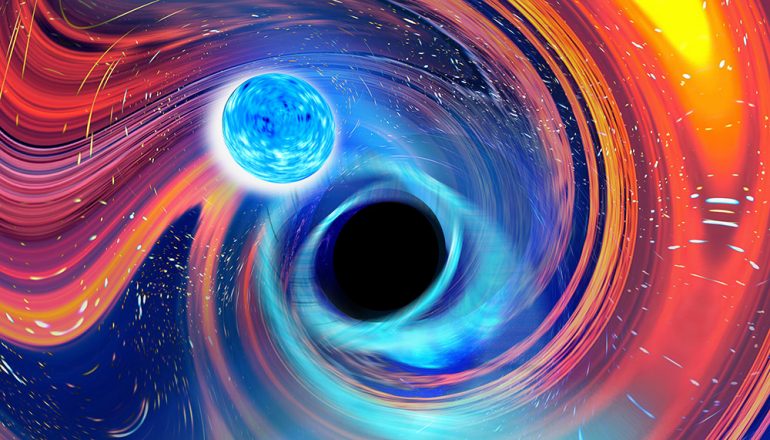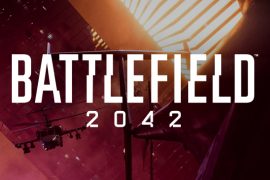Cosmic Pac-Man: Astronomers have captured the first apparent gravitational wave signals from a neutron star’s collision with a black hole. The LIGO and Virgo observatories detected two of these events in January 2020. The black hole probably swallowed the small neutron star whole, with no burst of radiation. The evidence for such mixed collisions opens up the opportunity to learn more about the origin, evolution and end of these dissimilar pairs.
since first proof In the 2016 count of gravitational waves, astronomers recorded more than 50 cosmic collisions with detectors LIGO and Virgo. Usually two stellar black holes merge, in some cases they did two neutron stars. Merger of two partners with extreme unequal population were already.
However, what was missing until now was clear evidence of a mixed pair – the collision of a neutron star with a black hole. There was one in April 2019 potential candidateHowever, the data position was too thin for clear evidence. Another event in June 2020 gives riddles Because the second companion was too light for a black hole, but slightly heavier for a neutron star.
two mixed collisions in a row
Now, for the first time, astronomers have caught clear signs of a neutron star colliding with a black hole. In January 2020, the LIGO detectors in the United States and the Virgo detector in Italy recorded gravitational waves from such a mixed pair for two consecutive times. “Gravitational waves alone do not tell us the structure of a lighter object, but we can determine its maximum mass,” explains Bhushan Gadre of the Max Planck Institute for Gravitational Physics in Potsdam.
These analyzes suggest that the smaller companion in both collisions may not have been a black hole, but rather a neutron star due to its low mass. In the event GW200105 on January 5, 2020, a black hole with 8.9 solar masses and a neutron star with 1.9 solar masses collided. The energy of this collision released gravitational waves that reached Earth about 900 million years later.
The second incident was recorded on January 15. GW200115 comes from a 5.7 solar mass black hole and a 1.5 solar mass neutron star, which collided about a billion light years away.
Is there any concomitant radiation?
Since the gravitational waves of this second collision reached both the LIGO detectors and the Virgo detector in good quality, astronomers were at least able to determine the likely location of the event. Using triangulation, he narrowed its position down to a region of the sky that roughly corresponds to the size of 3,000 full moons.
The determination of this rough position made it possible for other teams to use telescopes to search for the electromagnetic effects of the collision. Such bursts of radiation are mostly absent when two black holes collide, but they become apparent after neutron stars merge. detected. However, it is not clear whether they will also be released in a mixed collision. At least with GW200115 astronomers couldn’t find anything.
swallowed whole – like pac-man
Likely cause: The neutron star was probably swallowed whole by the black hole – leaving behind no radiation debris. “These weren’t events in which black holes first nibble on neutron stars and throw away scraps like a cookie monster,” explains LIGO spokesman Patrick Brady of the University of Wisconsin-Milwaukee. “This ejection would generate radiation, but we don’t think that happened in those cases.”
“In these collisions, two massive and dense objects don’t just come together and merge. It’s like Pac-Man: the black hole eats up its neutron star partner,” said co-author Susan of the Australian National University Scott says. “These are truly remarkable events and we have waited a long time to see them.”
many questions unanswered
Events GW200105 and GW200115 clearly show that these unequal collisions exist in the universe – and can be detected via gravitational waves. At the same time, however, these collisions open new opportunities for astronomers to investigate the origin, evolution and end of such mixed pairs in greater detail. “We don’t know a lot about neutron stars and black holes — how small or large they can be, how fast they spin, how they combine,” explains Maya Fischbach of Northwestern University in Evanston.
The LIGO and Virgo teams are currently optimizing their detectors to achieve even greater sensitivity for the next observation round in 2022. As the third member of the group, the Japanese Kagra Detector is also operating from 2020. (The Astrophysical Journal Letters, doi: 10.3847/2041-8213/c082e)
Quayle: University of Wisconsin – Milwaukee, Northwestern University, CNRS, Australian National University

Internet fan. Alcohol expert. Beer ninja. Organizer. Certified tv specialist. Explorer. Social media nerd.





